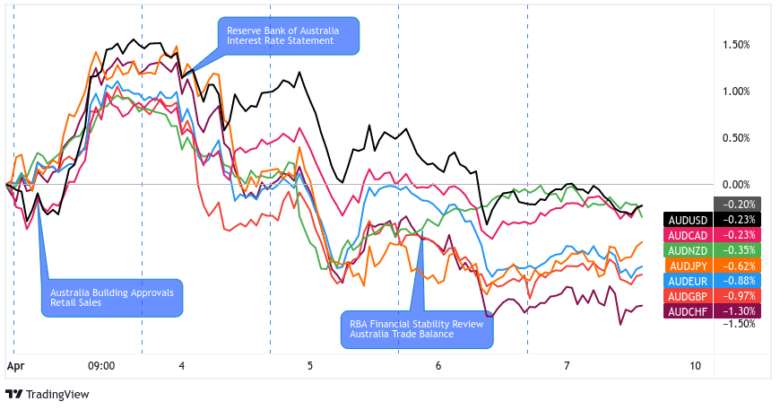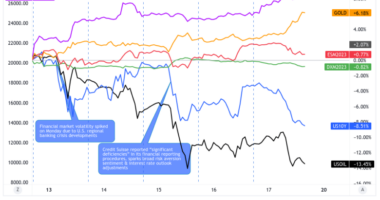It’s time for the folks over at the RBA to announce their policy decision very soon!
Will they decide to keep rates unchanged for another month? And what do the latest inflation figures imply for their policy plans?
Here’s what you need to know if you’re planning on trading this central bank announcement.
Event in Focus:
Reserve Bank of Australia Monetary Policy Statement
When Will it Be Released:
May 2, Tuesday: 4:30 am GMT, 5:30 am London, 12:30 am New York, 1:30 pm Tokyo
Expectations:
- RBA to keep interest rates on hold at 3.60%
- Potential revisions to inflation and rate forecasts for 2023
After last week’s generally lower-than-expected Q1 CPI release from the Land Down Under, the odds are looking strongly in favor of the RBA sitting on its hands again.
As in their earlier decisions, it doesn’t seem likely for the Australian central bank to call a peak in price pressures just yet.
Then again, they’re probably not gonna declare victory against inflation since the annual CPI is still significantly above their 2-3% target range.
Relevant Australian Data Since the Last RBA Statement:
? Arguments for Tighter Monetary Policy / Bullish AUD
April flash services PMI climbed from 48.6 to 52.6, reflecting a shift from contraction to industry expansion as employment rose at its fastest pace in five months; the survey also showed an increase in input costs and selling prices.
March employment change jumped 53K vs. projected 20.8K gain, following earlier 63.6K increase thanks to gains in both full-time and part-time hiring. Jobless rate held steady at 3.5% even with uptick in labor force participation.
Q1 producer prices quarterly: 1.0% q/q (0.8% q/q forecast) vs. 0.7% q/q previous
? Arguments for Looser Monetary Policy / Bearish AUD
Q1 consumer price index rate fell from 1.9% to 1.4% on a quarterly basis, bringing annual inflation down from 6.8% to 6.3% vs. 6.5% forecast. Trimmed mean CPI slipped from 1.7% to 1.4% quarter-over-quarter.
Q1 import prices tumbled by 4.8% quarter-over-quarter vs. estimated 0.4% uptick and previous 1.8% gain.
Q1 producer prices annualized: 5.2% y/y (5.0% y/y forecast) vs. 5.8% y/y previous
April Flash Manufacturing PMI fell from 49.1 to 48.1, reflecting sharper contraction in the industry as decline in new orders accelerated;
MI inflation expectations for March declined from 5.0% to 4.6% to signal lower forecasts for price pressures over the next 12 months
Previous Releases and Risk Environment Influence on AUD
Apr. 4, 2023
Action / results: The Aussie started the week off strong but wound up returning those early gains and more when the RBA announced its decision to pause from tightening.
In addition, their official statement toned down the hawkish rhetoric from “further tightening will be required” to “further tightening may well be needed” so many took this as a sign that policymakers will stand pat for much longer.
This was later on followed by RBA head Lowe’s speech, during which he cited that “the decision to hold rates steady this month does not imply that interest rate increases are over” and that “at our next meeting, we will again review the setting of monetary policy with the benefit of an updated set of forecasts and scenarios.”
Risk environment and Intermarket behaviors: It was a particularly busy week in terms of central bank decisions and top-tier economic releases, but price action leaned risk-off as the shortened trading week dragged on.
Resurfacing recession fears, stemming mostly from downbeat U.S. JOLTS job openings data, kept market players on edge and favoring lower-yielding currencies.
Mar. 7, 2023
Action / results: The RBA hiked interest rates by 0.25% from 3.35% to 3.60% as widely expected but toned down their hawkish remarks from the February meeting, citing that further tightening remains data dependent.
Furthermore, policymakers already dropped hints about a future pause, as they replaced “further increases in interest rates will be needed over the months ahead” with “further tightening of monetary policy will be needed to ensure that inflation returns to target” in the actual statement.
Risk environment and Intermarket behaviors: Risk aversion was the name of the game leading up to the March RBA decision, as traders had to contend with hawkish U.S. policy expectations and banking sector contagion fears.
Price action probabilities
Risk sentiment probabilities: Financial markets have been grappling with risk-off flows over the past few days again, thanks to the resurgence of recession fears and banking sector woes.
If this kind of gloomy mood extends to early next week, the Aussie might be off to an already wobbly start leading up to a potentially downbeat RBA announcement.
Australian Dollar scenarios
Base case: Aussie traders are already gearing up for yet another cautious announcement from the RBA, as the past couple of decisions contained more than enough hints that the tightening pause could last a few months.
In addition, sharply declining inflationary pressures as highlighted by the Q1 CPI report pretty much confirmed that the central bank would be better off playing it safe for now.
If AUD is already on shaky ground prior to the actual rate decision, look for potential breakdowns on consolidation or continuation patterns, particularly against lower-yielding counterparts like the yen, dollar, and franc.
Alternative Scenario: RBA Governor Lowe might once again attempt to keep Aussie traders on their toes by citing that any decision to pause doesn’t necessarily mark the end of their tightening cycle.
Policymakers could also opt to highlight positive surprises in jobs data, citing that these put upside pressure on wages and therefore overall inflation.
Any bit of forward guidance suggesting the possibility of at least one more hike before the end of the year could shift gears in favor of an AUD bounce as traders unwind the current base case scenario priced in.
In this case, look for potential long AUD opportunities at major inflection points against other commodity currencies, such as the Kiwi and Loonie.
After all, the BOC has also hit the pause button when it comes to hiking while the RBNZ might be looking at one of its last rate increases for the year.











